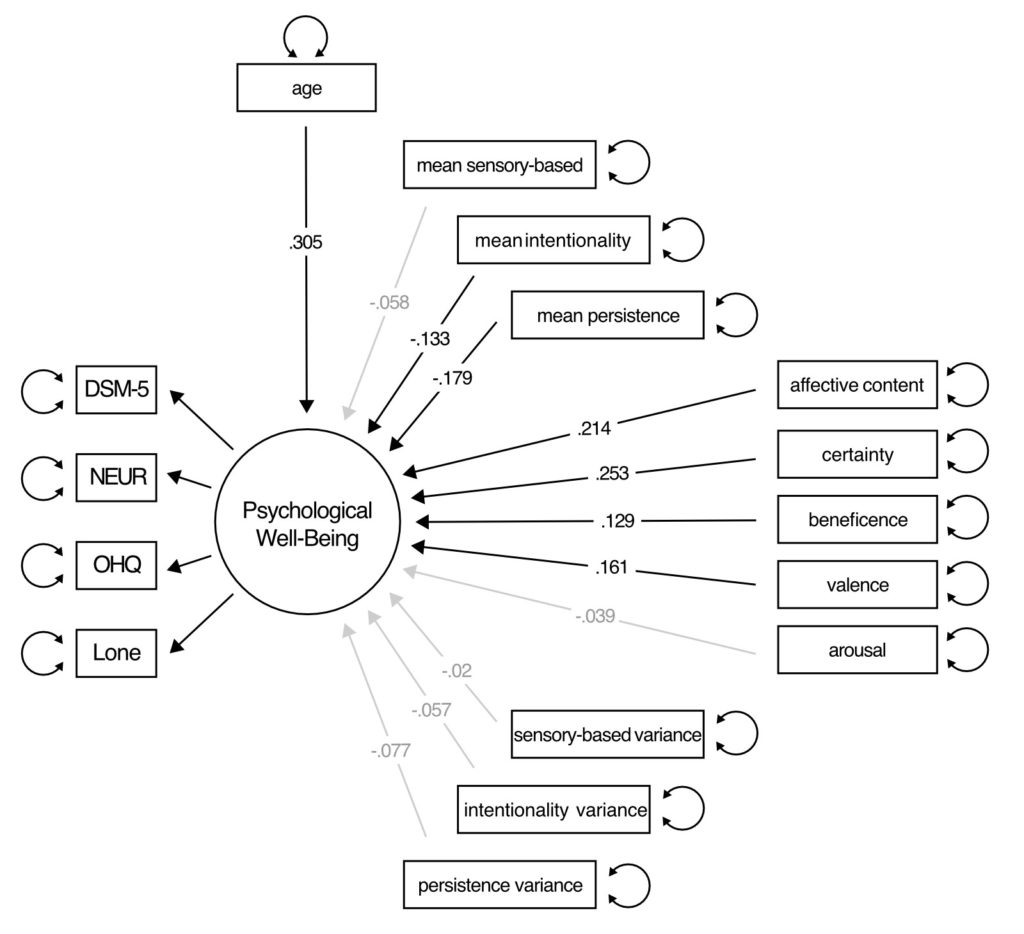A path-directed causal model that helped to confirm the contribution of foundational qualities of everyday thought on a multi-faceted construct of psychological well-being.
Skills used:
- Bayesian Inference
- Python & R
- Quantitative & Qualitative Statistics
Path modeling allows for the causal definition of relationships from which we can evaluate their statistical significance. Structural Equation Modeling (SEM) is a confirmatory path model method where we can make simultaneous estimates using two statistical approaches. The first, factor analysis, allows us to group variables into a unified ‘construct’ that is made up of by varying weights of those variables. The second, regression, is a method from which we can estimate the predictive value of one variable on another. Taken together, SEM allows us to test the validity in regard to how we group variables and define the relationships between variables.
In this project, I was testing the theoretical hypothesis that ‘foundational’ aspects of thoughts are related to psychological well-being (PWB). When we consider our everyday thoughts, these consist of a huge variety of qualities – the subject of what we’re thinking about, the timeframe of the thought, how long the thought stays in our head, etc. Some of these qualities, however, are not in all thoughts. For example, if I am thinking about a riddle, that thought doesn’t have a particular quality of ‘time’ to it (as compared to when I might be thinking of my 10th birthday which does have a strong ‘past-oriented’ timeframe). When we consider all of the types of thoughts that we have, I posited in this project that there are three qualities that all have:
- intentionality – whether a thought is brought about deliberately or if it occurs spontaneously
- domain – whether a thought is based on sensory information (i.e., the outside world) or if it is based on memory/imagination
- persistence – whether a thought ‘lingers’ for a period of time or if it is transient/fleeting
If we look at the video below, we can see the interaction of these three qualities. Each white ‘flash’ of a block represents a thought with the persistence dimension describing the duration of a thought.
To test the hypothesis, I created a path model that defined the relationship between these foundational characteristics, along with other predictors of PWB like age, the positivity of thoughts, and average valence (feeling of pleasantness/unpleasantness). Although the sample size for this model was adequate (with 304 participants), I chose to use Bayesian regression as it results in a probability distribution of estimated parameters and does not rely on a, highly subjective, “significance” concept. The complete model and standardized regression coefficients can be seen in the figure below. Solid lines and coefficients indicate those results that Bayesian inference saw as being different from zero with a 95% probability.

As we can see in the results, in this model, PWB is negatively related to intentionality and persistence of thoughts at a 95% probability. That is, the more deliberate one’s thoughts are, and the longer they linger, the lower one’s psychological well-being. When looking at other thought-related predictors, positivity, certainty, and helpfulness are all positive predictors of better psychological health. Additionally, some (unmeasured) aspect of being older and an average sense of positive feeling also predict higher levels of PWB.
This model illustrates some aspects of the hypothesized relationship in that two of the three foundational qualities of everyday thought have a probabilistically relevant connection to psychological well-being. Although these results mimic some of what we know from prior research (like the connection between being older and being more psychologically healthy), I was not expecting there to be a negative relationship between intentionality and PWB. The direction of that relationship seems counter-intuitive and not what we might expect from research on mindfulness. This result might be due to the inclusion of other explanatory qualities so additional analyses are planned to better clarify, and confirm, the results that are seen here.
